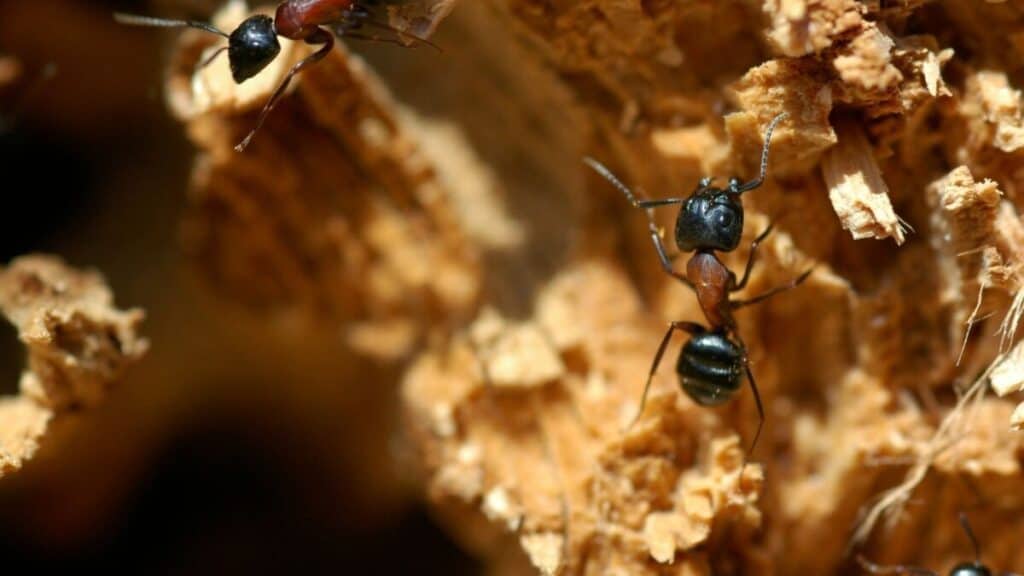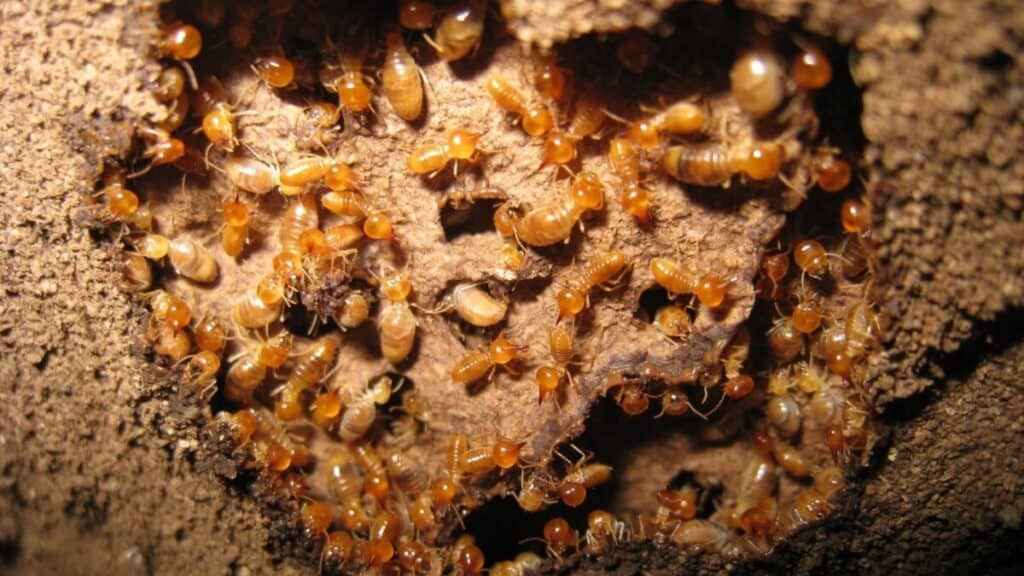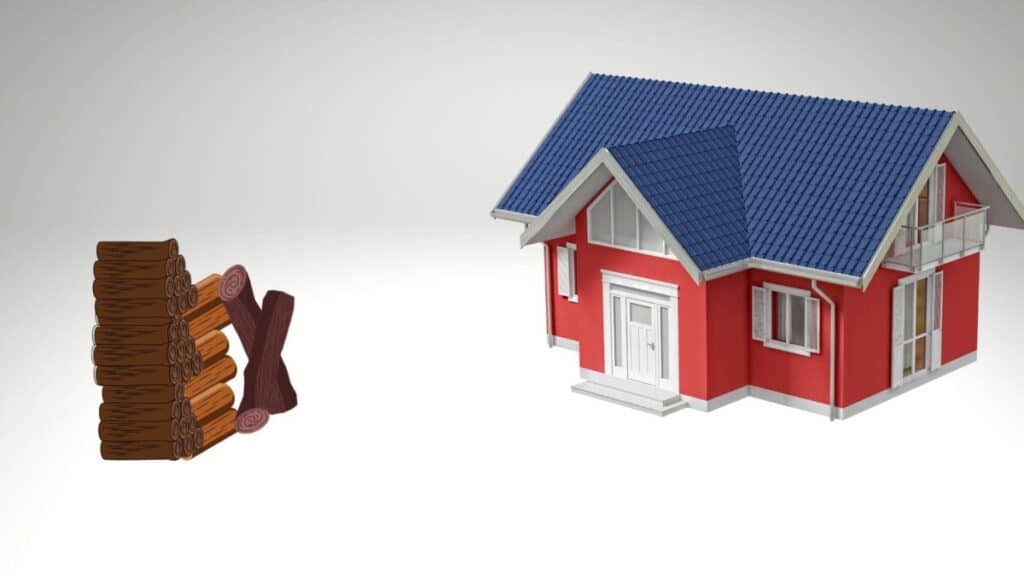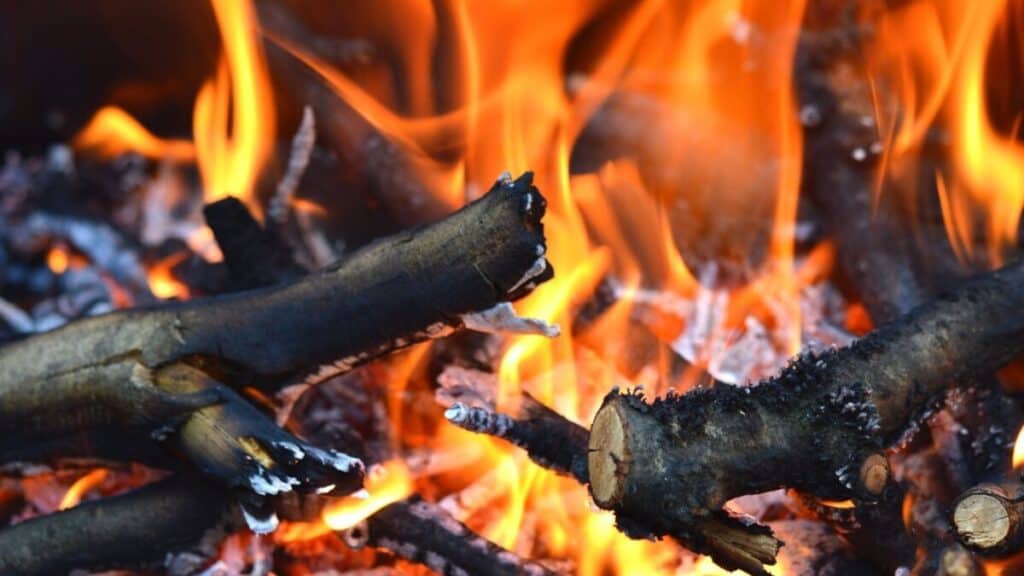
One thing that you can’t do, especially if you’re planning on bringing some of that wood inside to throw in the woodstove or fireplace, is apply any kind of pesticide.
You could possibly go with something natural but that usually doesn’t work and the wood will stink when it burns.
So, what can you do to keep bugs and pests out of your firewood, especially if you can’t kill them with a spray nozzle and some vicious, chemical warfare?
The only thing left for you is to find different ways to outsmart them.
Why Do Bugs Go for Your Firewood?
To understand how to get rid of them, you first have to understand why they are bothering to make a home in your firewood in the first place. Bugs need a home, just like anything else, including you.
Firewood provides them with plenty of shelter and is probably close to a good source of food and water, which is probably your home.
It’s a good place to settle in, breed, and expand their little empire amongst the bark and cracks in your wood stack.

- It attracts both predator and prey
- There is plenty of shelter from the elements
- Cellulose in the wood is a delicious treat for termites
- Typically goes undisturbed, especially in the warmer months
- Protects them from larger predators, such as birds
The list of bugs that will find your carefully stacked and organized woodpile, is large and varied.
Dry Wood
- Carpenter bees
- Wasps (horntail and wood)
- Yellow Jackets
Wet Wood
- Carpenter Ants
- Yellow Jackets
- Longhorn Beetles
- Bark Beetles
- Centipedes
- Powederpost Beetles
- Termites
The list is far more extensive than that, especially if your wood spends a great deal of time in a moist environment, or is exposed to the rain and elements.
You’re far more likely to endure a massive bug invasion if your woodpile is always wet than you will if you keep it dry.
How to Avoid Bugs Getting Into Your Woodpile
The best way to deal with bugs in your woodpile is to not let them in, to begin with. That means a little preventative maintenance is in order.
1. Keep Your Firewood Dry
If you notice from the above lists, there are a lot more bugs that will be happy to luxuriate and build their lavish homes in wet wood more so than they will in dry wood.

You can’t eliminate every bug by keeping your firewood dry, but you can sure cut down on a lot of them.
One of the most common methods is to secure a waterproof tarp over your pile of firewood. Be sure to conceal it with some strong straps or bungee cords so the wind won’t pick it up the first chance it gets.
2. Keep Your Firewood Up Off of the Ground
The first thought that comes to mind is wooden pallets, however, using wood to keep wood elevated is probably not the best idea.
Bugs will be attracted to the wood pallets on the ground and then realize they have a potential bug empire just above them.
Your best bet is to use cinder blocks to elevate a thick sheet of plywood. You can stack your firewood on top of the plywood sheet and secure it with a tarp and plenty of straps.
Angle your plywood slightly so gravity can do the job of running off the rain.
3. Keep Your Wood Stack Well Away from Your Home

One of the main reasons that bugs invade your woodpile is its proximity to your house. Your house offers a lot of appetizing features for a bug’s forever home.
It shields the pile from the wind and is a good source of nearby water and food.
The nearness of your home incentivizes breeding, as the bugs that are invading your woodpile will consider—in their own, bug-minded way—it an excellent place to grow their family of thousands.
4. Never Buy Your Firewood from Unknown Sources

All of the things that we’re talking about not doing here are the things that your shady firewood dealer may practice.
Fortunately, you’ll probably notice a bug problem when you’re loading the firewood and a centipede rolls out across your hand.
When it comes to purchasing firewood, you want to buy it from a reputable seller and know where the firewood is coming from along with where it has been stored as it awaited your eventual purchase.
5. Never Store It Inside Your Home
This is a much more egregious violation of the laws of storing firewood. You store it far away from your house to disincentivize bugs and to keep them from having a short walk to your house.
Storing firewood inside of your home is practically opening the door to a full-fledged termite invasion. In one, single act, you could destroy the value of your home.
6. Always Burn Your Wood from Oldest to Newest

Older wood is the most likely to have been invaded first.
It’s more accessible, as it’s usually the wood at the bottom of the stack, and it’s generally more porous and easy to get into, especially if it’s been there for a long time.
You can head off a wholesale invasion by simply burning the old wood first, which will get rid of a vast majority of any bugs before they decide to expand into newer and better wood.
How to Get Rid of Bugs After the Fact
Once the invasion has begun, it is what it is and, unless you’re going to burn them all quickly and efficiently, you’ll need to get rid of them.
There are a few things you can do to take bring the fight to them and clear them out before you lay the firewood next to the fireplace inside your home.
1. Borax

At the beginning of this article, we advised against pesticides and natural bug killers, simply because the pesticides are harmful when burned and the natural stuff hardly ever works.
Borax is one of the lone exceptions, along with Diatomaceous Earth.
Borax isn’t harmful when burned and it will kill everything with a hard exoskeleton and even some that accidentally ingest it. At a microscopic level, borax is nothing but an alien world of razor-sharp materials.
Those razor edges will slice and dice a bug carapace and do quite a number on their digestive systems if they ingest it.
2. Diatomaceous Earth

Diatomaceous Earth is almost exactly the same as Borax, with razor-sharp elements that will carve up most of the species of bugs that come into contact with it.
It’s long been a great material for combatting fleas. If it can deal with a tiny insect such as a flea, it can certainly ravage a colony of bugs in your firewood.
Diatomaceous Earth is often consumed by bugs as well, especially if, like the Borax, they consume it with a source of food.
Once inside their bodies, it acts much in the same way as Borax, tearing up their insides, dehydrating them, and ultimately, killing them.
3. Freeze Them Out
If you happen to own a deep freezer that has a little additional space, you can always stack firewood within it for a period of three days.
You’ll have to come up with an ideal rotation and it’s not likely that you will be able to do much else with the freezer while it’s in use.
Most articles discuss placing one piece of wood at a time but realistically speaking, that’s ridiculous unless you only have a single piece of wood in the whole of your firewood stack that has a big problem.
At the rate that a single person can burn through the wood in a wood stove or a fireplace means that you will need a good cycle of wood coming through and you will need to freeze a whole lot more than a single piece.
4. Give Them a Heat Stroke

One of the best things that you can do is strategically place your woodpile in direct sunlight.
All you have to do after that is engage in what is called the “greenhouse effect.” Wrap the entire stack—or a very large armful or two—of wood in a black tarp.
The heat that the black tarp will absorb will effectively wipe out any colonization efforts that your new bug neighbors are attempting to employ.
The heat will simply be too much for them, either driving them out or killing them by overheating.
It only takes a few hours at temperatures that exceed 130°F for the bugs to start dying in droves.
It will either choke them out and they will flee from the Sodom and Gomorrah that you have created or they will simply die of overheating.
All Things Considered
As you can see, getting rid of or keeping bugs out of your firewood stack is mostly about preventative maintenance. It’s much more difficult to get them out once they have established a foothold.
Your best bet is to avoid them altogether by strategically placing your firewood stack well away from your house, in direct sunlight, elevated, and covered with a black tarp.
If nothing else, it will make most bugs reconsider where they want to make their home.
Alright, that’s it for this article, here are a few hand-selected articles that you might also find interesting reads:
How To Spot and Prevent Termites from Causing Wood DamageHow to Keep Insects out of Your Garage – In Easy Steps
How to Keep Insects out of Your Porch! Easy Steps
Recent Posts
Tiny Black Bugs in Bathroom NO WINGS: What They Are and What to Do!
Finding tiny black bugs in your bathroom can be uncomfortable, to say the least. Especially if they are persistent, or they appear in very large numbers, which they often like to do. When it...
Tiny Black Bugs in Plant Soil - What Are They & What To Do About It
A short horror story: You get a new houseplant. You do your best to take care of it. You’ve ensured that it has the right soil, the right amount of sun, it gets enough water. And then one day, you...

